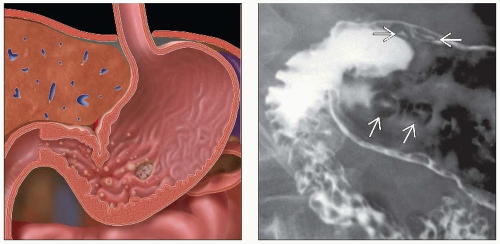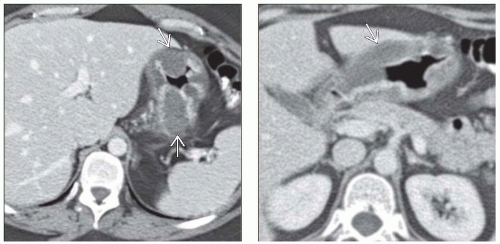Gastritis
Michael P. Federle, MD, FACR
Key Facts
Terminology
Inflammation of gastric mucosa induced by group of disorders that differ clinically but share similar imaging features
Common etiologies include H. pylori, NSAIDs, alcohol and coffee, stress
Imaging
Erosive gastritis, complete or varioliform erosions (most common type)
Erosions surrounded by radiolucent halos of edematous, elevated mucosa
Scalloped or nodular antral folds
Crenulation or irregularity of lesser curvature
Location: Gastric antrum on crests of rugal folds
Prolapse of antral mucosa through pylorus
Lack of complete distensibility of stomach (especially antrum)
CT: Decreased wall attenuation (edema or inflammation)
Close to water density
Upper GI series best for mucosal detail
CT for global view and concern for extragastric complications (e.g., perforation)
Top Differential Diagnoses
Gastric carcinoma
Zollinger-Ellison syndrome
Acute pancreatitis
Gastric metastases and lymphoma
Diagnostic Checklist
CT and upper GI usually suggest only gastritis
Specific etiology determined by other medical data ± endoscopic biopsy
TERMINOLOGY
Definitions
Inflammation of gastric mucosa induced by group of disorders that differs in etiological, clinical, histological, and radiological findings
Classification of gastritis
Erosive or hemorrhagic gastritis (2 types)
Complete or varioliform
Incomplete or “flat”
Antral gastritis
H. pylori gastritis
Hypertrophic gastritis
Atrophic gastritis (2 types: A and B)
Granulomatous gastritis (Crohn disease and tuberculosis)
Eosinophilic gastritis
Emphysematous gastritis
Caustic ingestion gastritis
Radiation gastritis
AIDS-related gastritis: Viral, fungal, protozoal, and parasitic infections
IMAGING
General Features
Best diagnostic clue
Superficial ulcers and thickened folds
Upper GI Findings
Erosive gastritis, complete or varioliform erosions (most common type)
Location: Gastric antrum on crests of rugal folds
Multiple punctate or slit-like collections of barium
Erosions surrounded by radiolucent halos of edematous, elevated mucosa
Scalloped or nodular antral folds
Epithelial nodules or polyps (chronic)
Erosive gastritis, incomplete or “flat” erosions
No surrounding edematous mucosa
Nonsteroidal antiinflammatory drugs (NSAID)-induced
Linear or serpiginous erosions clustered in body, on or near greater curvature
Varioliform or linear erosions in antrum
NSAID-related gastropathy: Subtle flattening and deformity of greater curvature of antrum
Antral gastritis
Thickened folds, spasm or decreased distensibility
Scalloped or lobulated folds oriented longitudinally or transverse folds
Crenulation or irregularity of lesser curvature
Prolapse of antral mucosa through pylorus
H. pylori gastritis
Location: Antrum, body, or occasionally fundus; diffuse or localized
Thickened, lobulated gastric folds
Enlarged areae gastricae (≥ 3 mm in diameter)
Hypertrophic gastritis
Location: Fundus and body
Markedly thickened, lobulated gastric folds
Atrophic gastritis
Narrowed, tubular, nondistensible stomach
Smooth, featureless mucosa, ↓ folds
Stay updated, free articles. Join our Telegram channel

Full access? Get Clinical Tree







